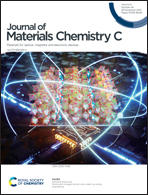Doping of a Zn-MOF with Eu3+ and Tb3+ for application in the manufacture of a WLED†
Abstract
A new blue light-emitting molecular–organic framework namely FQUNAM-MOF (1) was synthesized in a simple way using formic acid and zinc nitrate as precursors. In the present work, the potential of 1 as an efficient antenna for terbium and europium 3+ ions was evaluated at different dopant ratios. The compounds labelled Eu3+0.3−nTb3+n@1 where n = 0.15, 0.18, and 0.21, are isostructural and their luminescence properties were studied in detail. Excellent energy transfer occurs from the MOF-excited energy levels towards the 5D4 state in Tb3+, unlike Eu3+ where the sensibilization predominantly arises from the 5D4 terbium state. These compounds exhibit a high solid-state quantum yield (QY) from 23.4 to 48.5%, higher than the reported values, and they show thermal stability at high temperatures. Additionally, a white light-emitting device (WLED) was prepared using a resin in which 20% (w/w) of the Eu0.09Tb0.21@1 compound (48.5% QY) was added. It displayed a white-cold light emission colour according to the Commission Internationale de I’Éclairage (CIE) classification (applying current values of 10, 30, and 100 mA). These materials contribute to the emerging field of molecular–organic frameworks for the development of new efficient and stable lighting sources.



 Please wait while we load your content...
Please wait while we load your content...